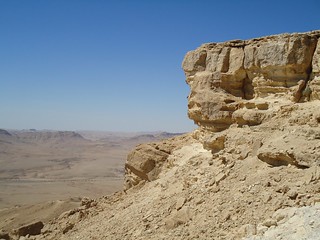Today we drove about 3 1/2 hours south to stay at Kibbutz Ketura and see the Arava Institute. We drove down Highway 40 and drove through the Makhtesh Ramon. It's not a crater, though that is what makhtesh means in Hebrew. It is a near look-alike of places in the southwest U.S., in particular near La Verkin, Utah, where I did my master's degree field work. A lot of geology we saw along the way here, such as the makhtesh, is a rift and the exposures are perfect. You can see in the map that it sort of looks like a crater from above yet it is a formation created similarly to the Grand Canyon, by water flowing. The water is mostly gone, and now it is pretty sparsely vegetated.
View Larger Map
Actually, the vegetation reminds me of California with bougainvillea, carob, pomegranat, oleander, but the Makhtesh Ramon was distinctly Grand Canyon-like with high, table-top plateaus with flat-lying sedimentary rocks and a valley that has black, low cones of volcanic material.
We arrived at Kibbutz Ketura and were greeted with a pretty amazing heat. Nevada heat. Death Valley heat. We cooled off in the kibbutz pool.
 We were given a tour of the kibbutz where 400 people live. We keep hearing that the kibbutzim are dying out, that there's no interest in this collective lifestyle. But, in theory, it sounds like a great idea. Everyone works. Everyone contributes to the kibbutz. Everyone eats and gets health care and an education. Instead of all adults owning one car each, as is the case in the U.S., as is the case in my house, there are shared cars. OK, you have way less freedom to do whatever you want but you're using far fewer resources, buying much less junk, and if you grow your own food or buy thoughtfully, you can make a huge impact on your body and the bodies of your neighbors.
We were given a tour of the kibbutz where 400 people live. We keep hearing that the kibbutzim are dying out, that there's no interest in this collective lifestyle. But, in theory, it sounds like a great idea. Everyone works. Everyone contributes to the kibbutz. Everyone eats and gets health care and an education. Instead of all adults owning one car each, as is the case in the U.S., as is the case in my house, there are shared cars. OK, you have way less freedom to do whatever you want but you're using far fewer resources, buying much less junk, and if you grow your own food or buy thoughtfully, you can make a huge impact on your body and the bodies of your neighbors.


No comments:
Post a Comment